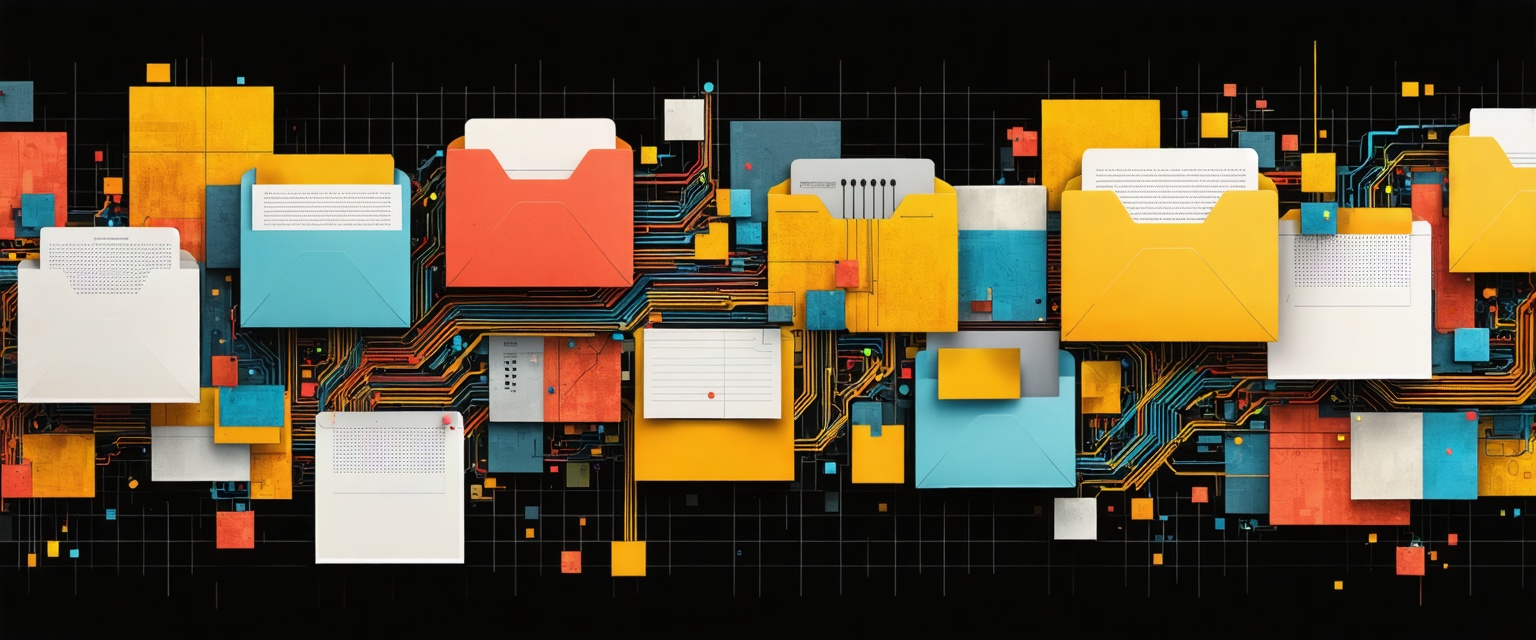All Posts
Document data extraction and handling
Mastering Word Files: Automate Digitization with AI-Powered Tools

Discover how to automate Word file digitization using AI tools. Revolutionize productivity, reduce errors, and integrate seamlessly with business systems.
Are you drowning in Word documents that need to be processed, extracted, and connected to your business systems? Learning how to automate Word file digitization can revolutionize your productivity.
Document automation is changing the game for businesses by transforming static documents into dynamic, reusable assets that work for you—eliminating manual data entry, reducing errors, and creating consistent business processes.
In this article, we will discover how solutions like Datagrid's data connectors can automate scanned document digitization, extract information from any document format, and seamlessly connect with over 100 different platforms.
AI and Machine Learning Solutions for Automating Word Files Digitization
AI and machine learning technologies have changed how organizations extract insights from digitized Word documents. These tools unlock PDF digitization efficiency, turning static documents into rich sources of actionable information, driving better decisions and operational efficiency—key outcomes when automating Word files digitization.
Natural Language Processing for Content Analysis
Natural Language Processing (NLP) is particularly effective at understanding and analyzing the content within digitized Word files. With NLP, you can:
- Classify text automatically - Sort documents into relevant categories based on their content, helping organize large collections of Word files by topic, department, or priority
- Identify important entities - Extract key information like names, organizations, locations, and dates through Named Entity Recognition, quickly surfacing critical information
- Analyze sentiment - Determine whether document sections express positive, negative, or neutral sentiments, particularly valuable when analyzing customer feedback or surveys
- Model topics - Identify the main themes discussed across document collections, providing high-level overviews of content without manual reading
- Generate summaries - Create concise summaries of longer documents, extracting the most important points automatically
- Extract keywords - Identify the most significant terms and phrases, making documents more searchable and helping spot trends
Intelligent Document Processing Platforms
Intelligent Document Processing (IDP) platforms take document analysis further by combining AI, machine learning, and computer vision to process both the text and visual elements of Word documents.
Modern IDP solutions offer:
- Automated data extraction - Pull specific information from semi-structured documents like forms, contracts, or invoices with minimal manual intervention
- Document classification and indexing - Automatically categorize and automate document indexing files based on their content and structure, even when templates vary
- Table extraction - Recognize and convert tabular data from Word documents into structured formats like CSV or database entries
- Handwriting recognition - Process scanned Word documents containing handwritten notes, converting them to machine-readable text
These AI solutions can automate document parsing, scale effectively with growing document volumes, and continuously improve as they process more of your organization's specific document types.
By combining NLP and IDP technologies, you can transform your digitized Word files from static documents into dynamic information resources that integrate with your broader data strategy.
Integration with Enterprise Systems
Integrating digitized Word files with enterprise systems like CRM, ERP, and document management platforms streamlines workflows, improves data accessibility, and enhances collaboration across your organization. By connecting your digitized documents with core business systems, you can eliminate data silos and create a more efficient information ecosystem.
API-Based Integration Approaches
Application Programming Interfaces (APIs) allow different software systems to communicate and share data seamlessly. This integration method provides flexibility and customization options for connecting your digitized Word files with enterprise systems.
Key advantages of API-based integration include:
- Real-time data synchronization between systems
- Customizable document workflows that match your business processes
- Automated document generation and processing
Document Management System Integration
While APIs offer powerful custom integration capabilities, document management systems provide comprehensive platforms specifically designed for document handling and integration with enterprise systems.
Document management systems offer several benefits for integration:
- Centralized storage of all digitized Word files
- Version control and audit trails to track document history
- Metadata tagging for improved searchability
- Role-based access controls for document security
Cloud-based platforms offer native integration with business systems such as Dynamics 365 CRM, allowing for seamless document management within your CRM environment. This integration eliminates the need for separate systems and provides a unified experience for users.
Best Practices for Successful Integration
Regardless of which integration approach you choose, following these best practices will help ensure successful implementation and maintenance of your integrated document systems:
- Optimize workflows: Organize documents in a way that makes them easy to find and access by defining a clear structure and taxonomy. This improves user adoption and efficiency.
- Capture documents early: Store documents in your enterprise systems as soon as possible, whether by scanning paper or adding digital files. This ensures that all team members have access to the most current information.
- Implement version control: Use a system that maintains document integrity by tracking changes and preserving previous versions. This prevents information loss and confusion about which document is the most current.
- Set appropriate permissions: Assign access rights to specific teams and individuals to keep information relevant and protected. This maintains data security while ensuring the right people have access.
- Leverage metadata: Use metadata tagging to improve searchability and organization of digitized Word documents within enterprise systems. This makes finding relevant documents much faster and more efficient.
- Automate where possible: Implement automated document routing and approval processes to streamline operations and reduce manual tasks.
- Provide adequate training: Ensure your team understands how to use the integrated systems effectively to maximize adoption and ROI.
By implementing these integration approaches and best practices, you can create a seamless connection between your digitized Word files and enterprise systems, improving efficiency and information access across your organization.
Choosing the Right Method for Automating Word Files Digitization
When it comes to automating Word files digitization, one size doesn't fit all. Your organization's specific needs, resources, and technical capabilities should guide your choice of digitization method. By systematically evaluating your requirements, you can select the approach that will deliver the most value.
Assessing Your Document Digitization Needs
Before implementing any digitization method, take stock of these critical factors:
- Document Volume: The number of documents you need to process will significantly impact your choice. For small volumes, manual methods or basic tools like Find and Replace may suffice. For large document libraries, automated solutions like macros or third-party tools become essential.
- Document Complexity: Consider the structure and format of your documents. Simple text documents with consistent formatting are easier to digitize than complex documents with tables, images, and varying layouts.
- Accuracy Requirements: Some industries (like legal, financial, or healthcare) require extremely high accuracy levels. In these cases, advanced OCR with AI verification or human review processes may be necessary.
- Integration Needs: Consider how digitized documents will interact with your existing systems. If you need to connect with CRM, ERP, or document management systems, look for methods that offer robust API capabilities.
- Available Technical Expertise: Be realistic about your team's technical capabilities. While macros might be powerful, they require programming knowledge that your team may not possess.
- Budget Constraints: Advanced digitization methods often require greater investment. Balance the cost against potential productivity gains and error reduction.
Planning a Phased Implementation Approach
Rather than attempting to transform all your document processes at once, consider this phased implementation strategy:
- Start with Quick Wins: Begin with simple digitization methods like templates that deliver immediate productivity benefits with minimal investment.
- Build Technical Capability: As your team gains confidence, introduce more advanced techniques like Content Controls or basic macros.
- Pilot Advanced Solutions: Test sophisticated digitization methods on a small scale before full deployment. For example, implement OCR for one department before rolling out company-wide.
- Integrate and Expand: Once basic digitization is working well, focus on integration with other systems and expanding your document automation ecosystem.
- Continuous Optimization: Regularly review your digitization processes, measuring effectiveness against key metrics like time saved, error reduction, and user satisfaction.
By thoughtfully assessing your needs, matching methods to requirements, and implementing in phases, you'll maximize the benefits of automating Word files digitization while minimizing risks and disruption to your organization.
How Agentic AI Simplifies Task Document Digitization
Think about extracting data from any document format and connecting it with over 100 different platforms—without writing a single line of code. That's what Datagrid's agentic AI technology and data connectors can do for you.
Effective task automation depends on connecting different systems and letting them talk to each other seamlessly. Datagrid's data connectors build bridges between your most important business platforms.
These connectors work with popular CRM systems like Salesforce, HubSpot, and Microsoft Dynamics 365, keeping your customer information, lead data, and sales pipeline stages in sync across all systems. No more manual data entry or tedious exports and imports—your information flows automatically where it needs to go.
The integration goes beyond CRM to marketing automation platforms too. Connected with tools like Marketo and Mailchimp, Datagrid ensures your email campaign metrics and lead scoring data transfer smoothly between systems. This creates a unified view of your marketing efforts and breaks down information silos that slow you down.
What's most impressive is Datagrid's ability to extract and use data locked in various document formats. Whether you're dealing with PDF contracts, scanned invoices, or complex spreadsheets, the AI agents can identify, extract, and route the relevant information to where it matters most in your workflow—simplifying the digitization of Word files.
By automating these routine but time-consuming processes, Datagrid frees you to focus on activities that truly need human insight and creativity. The platform handles repetitive data management tasks behind the scenes, boosting your productivity while reducing errors.
Simplify Data Processing with Agentic AI
Don't let data complexity slow down your team. Datagrid's AI-powered platform is designed specifically for insurance professionals who want to:
- Automate tedious data tasks
- Reduce manual processing time
- Gain actionable insights instantly
- Improve team productivity
See how Datagrid can help you increase process efficiency.
Create a free Datagrid account












